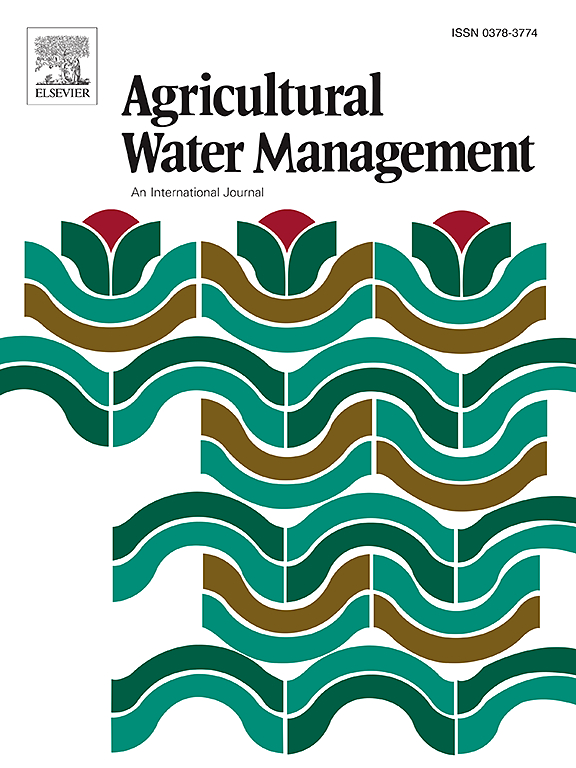Multi-objective optimization of soil water-nitrogen management practice and seeding rate for sustainable soybean production on the Loess Plateau of China
IF 6.5
1区 农林科学
Q1 AGRONOMY
引用次数: 0
Abstract
Improved soil and crop management practices are essential for enhancing soybean production, but a comprehensive evaluation of agronomic performance, economic benefit and environmental sustainability associated with various soil and crop management practices is still missing. Field experiments were performed on soybean using a split-split plot design on the Loess Plateau of China in 2019 and 2020, with soil water management practice as the main plot (NM: flat cultivation; RF: ridge-furrow cultivation with film mulch; RW: ridge-furrow cultivation with film mulch and supplemental irrigation), nitrogen rate as the sub-plot (N30: 30 kg N ha−1 and N60: 60 kg N ha−1) and seeding rate as the sub-sub plot (D16: 160,000 plants ha−1 and D32: 320,000 plants ha−1). A multi-level multi-objective fuzzy comprehensive evaluation model was established for analysis. The results indicated that the soil water-nitrogen management practice and seeding rate (p < 0.01) as well as the interaction between nitrogen rate and seeding rate significantly (p < 0.01) affected the growth, photosynthetic capacity, grain yield and its components, seed quality, economic benefits and resource use efficiency of soybean. The RWN30D32 treatment achieved the highest ranking for multi-objective optimization in both growing seasons. Compared with the local management strategy (NMN60D16), RWN30D32 significantly (p < 0.05) increased the canopy photosynthetic capacity, biological yield, grain yield, seed protein yield, seed oil yield, net income, ratio of output over input costs, crop water productivity, partial factor productivity of nitrogen and radiation use efficiency by 22.8 %, 66.7 %, 35.9 %, 20.1 %, 23.9 %, 69.8 %, 28.4 %, 29.0 %, 171.8 % and 18.5 %, while it decreased the hundred-grain weight, number of pods, seed protein content, seed oil content, energy use efficiency and carbon productivity by 5.4 %, 34.2 %, 11.6 %, 8.8 %, 20.5 % and 69.0 %, respectively. In conclusion, the optimized management practice exhibited significant improvements agronomic performance, economic benefits and resources use efficiency, which was recommended for sustainable soybean production on the Loess Plateau of China.
黄土高原大豆可持续生产土壤水氮管理措施及播量多目标优化
改良土壤和作物管理方法对提高大豆产量至关重要,但目前仍缺乏对各种土壤和作物管理方法相关的农艺性能、经济效益和环境可持续性的综合评价。2019年和2020年在黄土高原以土壤水分管理实践为主要小区(NM:平耕;RF:地膜垄沟栽培;RW:垄沟覆膜补灌栽培),施氮量为分块(N30: 30 kg N ha - 1和N60: 60 kg N ha - 1),播量为分块(D16: 16万株ha - 1和D32: 32万株ha - 1)。建立了多层次多目标模糊综合评价模型进行分析。结果表明,土壤水氮管理措施和播量(p <; 0.01)以及施氮量与播量的交互作用(p <; 0.01)显著影响大豆的生长、光合能力、籽粒产量及其组成、种子品质、经济效益和资源利用效率。RWN30D32处理在两个生长季节的多目标优化排名最高。与当地管理策略(NMN60D16)相比,RWN30D32显著(p & lt; 0.05)增加了树冠光合能力、生物产量、籽粒产量、蛋白质产量、种子籽油产量、净收益,比输出/输入成本,作物水分生产率,偏要素生产率的氮和辐射利用效率22.8 % 66.7 % 35.9 % 20.1 % 23.9 % 69.8 % 28.4 % 29.0 % 171.8 % 18.5 %,虽然hundred-grain体重下降,吊舱,籽粒蛋白质含量、籽粒油含量、能量利用效率和碳生产力分别提高了5.4 %、34.2% %、11.6 %、8.8 %、20.5 %和69.0% %。综上所述,该优化管理措施具有显著的农艺性能、经济效益和资源利用效率的提高,可用于黄土高原大豆可持续生产。
本文章由计算机程序翻译,如有差异,请以英文原文为准。
求助全文
约1分钟内获得全文
求助全文
来源期刊

Agricultural Water Management
农林科学-农艺学
CiteScore
12.10
自引率
14.90%
发文量
648
审稿时长
4.9 months
期刊介绍:
Agricultural Water Management publishes papers of international significance relating to the science, economics, and policy of agricultural water management. In all cases, manuscripts must address implications and provide insight regarding agricultural water management.
 求助内容:
求助内容: 应助结果提醒方式:
应助结果提醒方式:


